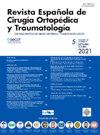老年人并发上肢和髋部骨折:我们中心的经验。
Q3 Medicine
Revista Espanola de Cirugia Ortopedica y Traumatologia
Pub Date : 2025-05-01
DOI:10.1016/j.recot.2024.06.001
引用次数: 0
摘要
简介老年人髋部骨折的发病率呈上升趋势,偶尔还伴有上肢骨折。我们的调查旨在确定,与单独发生髋部骨折的患者相比,这些患者的功能预后是否更差、住院时间是否更长、死亡率是否更高:我们对本中心在 2017 年 1 月至 2020 年 3 月期间收治的 1088 名髋部骨折老年患者进行了回顾性研究。我们记录了合并骨折及其治疗情况。我们分析了住院时间、院内死亡率和功能:我们发现有 63 名患者同时伴有上肢骨折(5.6%)。其中,93.7%为女性,平均年龄为86.4岁。80.9%的上肢骨折为桡骨远端或肱骨近端骨折。合并骨折的患者住院时间延长(平均为19.6对12.8,P=0.002),出院时返回自己家中的比例降低(23.6%对26.3%,P=0.042),院内死亡率增加(9.5%对5.9%,P=0.003):结论:合并上肢骨折的患者住院时间较长,院内死亡率较高。结论:合并上肢骨折的患者住院时间更长,院内死亡率更高,此外,这种情况还与短期功能恢复能力下降有关,从而降低了患者出院后回家的机会。本文章由计算机程序翻译,如有差异,请以英文原文为准。
Fracturas concomitantes de miembro superior y cadera en pacientes mayores de 65 años: experiencia en nuestro centro
Introduction
The incidence of hip fracture in the elderly is on the rise, occasionally accompanied by concurrent upper limb fractures. Our investigation aims to determine whether these patients experience poorer functional outcomes, prolonged hospitalization, or higher mortality rates when compared to those with isolated hip fracture.
Material and methods
We retrospectively reviewed 1,088 elderly patients admitted to our centre with hip fracture between January 2017 and March 2020. We recorded the presence of concomitant fractures and their treatment. We analyzed the duration of hospital stay, in-hospital mortality and function.
Results
We identified 63 patients with concomitant upper limb fracture (5.6%). Among them, 93.7% were women, and the average age was 86.4 years. 80.9% of the upper limb fractures were distal radius or proximal humerus. Patients with concomitant fracture had increased length of stay (mean, 19.6 vs, 12.8, p = 0.002), decreased proportion of patients returning to their own home at discharge (23.6% vs, 26.3%, p = 0.042) and increased in-hospital mortality rate (9.5% vs, 5.9%, p = 0.003).
Conclusions
Patients with concomitant upper limb fracture require a longer length of stay and exhibit an elevated in-hospital mortality rate. Furthermore, this condition is associated with a reduced short-term functional recovery, thereby decreasing the chances of the patient returning home upon hospital discharge.
求助全文
通过发布文献求助,成功后即可免费获取论文全文。
去求助
来源期刊

Revista Espanola de Cirugia Ortopedica y Traumatologia
Medicine-Surgery
CiteScore
1.10
自引率
0.00%
发文量
156
审稿时长
51 weeks
期刊介绍:
Es una magnífica revista para acceder a los mejores artículos de investigación en la especialidad y los casos clínicos de mayor interés. Además, es la Publicación Oficial de la Sociedad, y está incluida en prestigiosos índices de referencia en medicina.
 求助内容:
求助内容: 应助结果提醒方式:
应助结果提醒方式:


